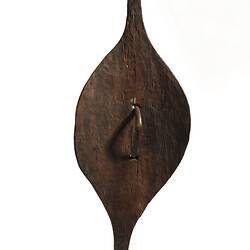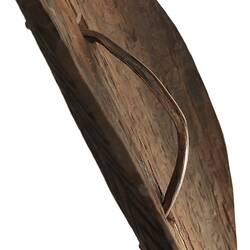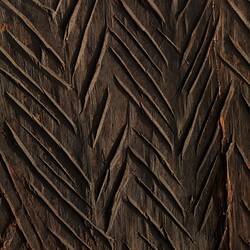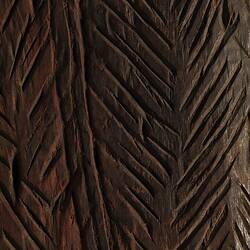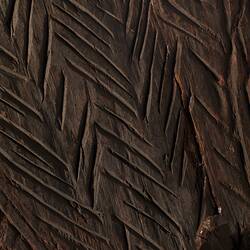Summary
This wokali (spear shield) was made by a Kaurna warrior, and is a significant cultural treasure due to both its antiquity and the rarity of examples of material culture from the Kaurna from this period. This beautiful wokali was made at the time Europeans first entered the land of the Kaurna in 1836. It is made from the inner wood of a eucalyptus tree and is decorated with an engraved design and red ochre.
The wokali were used by Kaurna men during battles that were held on the Adelaide Plains, These often occurred with rival groups from the Mount Barker and Murray River regions and the wokali were often broken and discarded on the battle field. As many as 200 men were involved in some of the larger battles recorded during the 1830s and 1840s.
Historical records and paintings of Kaurna warriors using their wokali during combat show the spear shields were predominantly decorated with painted designs using white pipe-clay and red ochre. Curved bands were the most comment element in painted decoration, which acted as a visual deflector, focusing the eye of the attacker away from the centre of the shield.
Local Name
Wokali
Physical Description
Pipette shaped shield that is bi-convex in cross section, handle is free standing and attached. The anterior surface has been decorated with an incised herringbone pattern and painted with red, white and yellow ochre which is now very faded. It is made from Eucalypt wood.
Significance
This wokali (spear shield) was made by the Kaurna peoples of the Adelaide Plains, South Australia, whose lands extend from Cape Jervis at the bottom of the Fleurieu Peninsula to Port Wakefield in the east and as far north as Crystal Brook. In recent times there has been a revival of Kaurna language and the Kaurna people's culture and history are at the fore in Adelaide through major public artworks in prominent locations which incorporate Kaurna language and themes. The Adelaide City Council has worked with prominent Kaurna Elders to enact a place-naming initiative which has seen all the city parks, squares and the river which runs through the city reinscribed with Kaurna names.
More Information
-
Object/Medium
Shield
-
Maker
-
Locality
-
Date Produced
-
Collector
-
Date Collected
-
Object Measurements
790 mm (Length), 320 mm (Width), 75 mm (Height)
-
Classification
-
Date Made
-
Maker
-
Clan/Language Group
-
Place Made
-
Indigenous Region
-
Collection Names
-
Type of item
-
Discipline
-
Category
-
Collecting Areas


